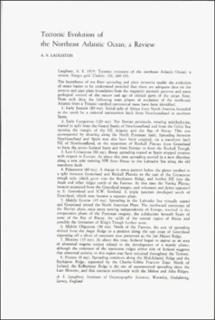| dc.contributor.author | Laughton, A.S. | |
| dc.date.accessioned | 2020-08-26T13:14:43Z | |
| dc.date.available | 2020-08-26T13:14:43Z | |
| dc.date.issued | 1975 | |
| dc.identifier.uri | https://hdl.handle.net/11250/2675014 | |
| dc.description.abstract | The hypotheses of sea floor spreading and plate tectonics enable the evolution of ocean basins to be understood provided that there are adequate data on the present and past plate boundaries from the magnetic anomaly patterns and some geological control of the nature of age of critical parts of the ocean floor. From such data, the following main phases of evolution of the north-east Atlantic from a Triassic unrifted continental mass have been identified: 1. Early Jurassic (80 my). 2. Early Cretaceous (120 my). 3. Late Cretaceous (80 my). 4. Palaeocene (60 my) 5. Middle Eocene (45 my). 6. Middle Oligocene (30 my). 7. Miocene (15 my). 8. Present (0 my). | |
| dc.language.iso | eng | |
| dc.relation.ispartofseries | NGU (316) | |
| dc.rights | Navngivelse 4.0 Internasjonal | |
| dc.rights.uri | http://creativecommons.org/licenses/by/4.0/deed.no | |
| dc.subject | TEKTONIKK | |
| dc.subject | STRATIGRAFI | |
| dc.title | Tectonic evolution of the Northeast Atlantic ocean: a review. | |
| dc.type | Journal article | |
| dc.description.localcode | 35900 | |
| dc.source.pagenumber | 169-193 | |

